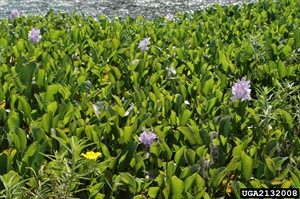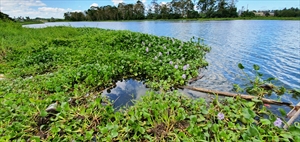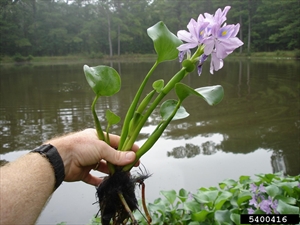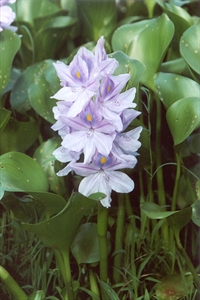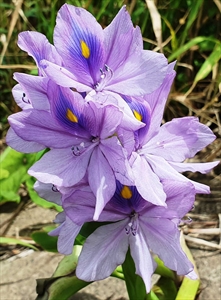Water hyacinth
Pacific Pests, Pathogens and Weeds - Online edition
Pacific Pests, Pathogens & Weeds
Water hyacinth (455)
Eichhornia crassipes. It was known previously as Eichhornia speciosa. It is a member of the Pontederiaceae.
Asia, Africa, North, South and Central America, the Caribbean, Oceania. It is recorded from Australia, American Samoa, Cook Islands, Federated States of Micronesia, Fiji, French Polynesia, Guam, Marshall Islands, Nauru, New Caledonia, New Zealand, Northern Mariana Islands, Palau, Papua New Guinea, Samoa, Solomon Islands, and Vanuatu.
Water hyacinth is native to Brazil, and perhaps to other Central and South American countries.
A major invasive weed of slow-flowing water: rivers, swamps, ponds, lakes, dams, lagoons, drains and rice fields of the tropics and subtropics (Photos 1-3). Growth is extremely rapid, forming dense mats, which reduce flow, and destroy natural wetlands and waterways, indirectly killing native fish, plants and birds, and forming breeding sites for mosquitoes. Often, especially abundant when there are high levels of nutrients in the waters.
Water hyacinth is a free-floating waterweed up to 65 cm tall for dense masses. Stems (stolons), on or just under the water surface, produce plants at their tips, which develop into daughter plants (Photo 4). Leaves in a rosette, around a crown region containing the shoot; they are dark green, with rounded leaf blades, up to 15 cm wide (Photo 5). Leaf stalks of uncrowded plants are swollen, spongy, bulbous (Photos 4&5), whereas those in crowded situations are slender and without swellings (Photo 6). Flowers (5-20) are borne on an erect stalk, about 15 cm long, each 4-6 cm long and 3.5-5 cm wide (Photos 6&7). The flowers are made up of six lilac to blue parts (three petals and three sepals), with a yellow spot in the top one (Photos 8&9). A fruit capsule beneath each flower, 10-15 mm long), contains up to 300 seeds. Seeds are egg-shaped, 0.5–1.5 mm long. The seeds germinate on the shorelines, where they can remain viable for 5-20 years. The root system is extensive (up to 1 m) feathery, fibrous, black to purple.
Spread by natural means is by vegetative reproduction and seed. Daughter plants become independent when wind (or boats) separates them. Seeds are produced beneath the flowers in a capsule; after flowering the stalk bends into the water, and about 2 weeks later the seeds are released. Long distance spread within and between countries is by human beings using the plant as an aquatic ornamental.
The weed has economic and social impacts, often intertwined. Costs of clearing the weed to maintain thoroughfares through the dense mats are high, e.g., experience of Panama Canal, parts of Nile, Lake Victoria and southern USA. Livelihoods are impacted, e.g., lower reaches of the Sepik River in Papua New Guinea, where people have difficulty accessing subsistence gardens, hunting and fishing areas, and markets. In Asia, the water hyacinth reduces the flow of irrigation water by blocking rice drains and canals, and competes directly with rice in paddy fields. In general, there are increased costs in maintaining boats, especially their engines, rivers and lakes are no longer fit for recreation and tourism, water quality is reduced, and mosquito-borne diseases increase, such as malaria, encephalitis and filariasis.
Environmental issues are profound. The free-floating weed quickly and easily spreads throughout aquatic ecosystems, where, under ideal conditions, it can double in number in less than 10 days. This impacts local ecology: native plants, birds and fish are killed or displaced. In slow-moving and still waterbodies it is especially problematic: dense mats lower dissolved oxygen levels, shade-out native submersed plant species, and interfere with nearshore breeding grounds of fish. Even in Australia, where there have been positive effects of biological control, it is still a significant environmental weed.
Young leaves and leaf stalks are cooked and eaten. Can be used as a green manure or a mulch.
BIOSECURITY
There is a high risk of introducing this weed. Countries not yet infested should consider all likely pathways for entry, and apply quarantine measures accordingly. Particular attention should be given to the risks associated with the international trade in ornamental and aquarium plants.
Eichhornia crassipes is a restricted invasive plant under biosecurity acts in some parts of Australia; this means - a person must not release these invasive plants into the environment, give away or sell as a plant or something infested with its seeds. In Fiji, it is listed as a noxious weed - prohibited plant that must be controlled - they serve no economic purpose and possess characteristics that are harmful to humans, animals or the environment.
Eichhornia crassipes is among 100 of the World's Worst Invasive Alien Species compiled by the Global Invasive Species Database, maintained by the IUCN Invasive Species Specialist Group, 2020. Available online.
BIOLOGICAL CONTROL
Waterhouse & Norris summarise the situation: many natural enemies are known, but in most countries only some have been released and, of those, many have probably not established. The impact of these natural enemies may be slow in coming, so successes may still occur. CABI provides an update, and documents countries were successes have occurred.
The important natural enemies are: two weevils, Neochetina eichhorniae and Neochetina bruchi; three moths, Niphograpta (Epipagis) albiguttalis, Xubida (Acigona) infusellus and Bellura densa; a mirid, Eccritotarsus catariensis; a mite Orthogalumna terebrantis, and several fungi. The situation is complex, for instance, temperature may play a part, and there are different preferences among the natural enemies, for instance, Niphograpta albiguttalis prefers bulbous leaf stalks, whereas Xubida infusellus the slender ones. A grasshopper, Cornops aquaticum, is under investigation as a biocontrol agent in South Africa.
CULTURAL CONTROL
- Physical & Mechanical
- Check water nutrient levels. Those of nitrogen and phosphorous should be reduced, e.g., it is important to prevent sewage entering waterways, as well as the run-off from agricultural lands.
- Use floating booms to prevent movement of weed into waterways.
- Use manual removal with rakes or, if funds allow, mechanical harvesting and crushing. If the weed is returned to water after crushing check that it does not de-oxygenate the water when decomposing.
CHEMICAL CONTROL
Herbicides can be effective, but they are not without problems and concerns. 2,4-D has been used because it is relatively inexpensive, but some formulations are toxic to aquatic organisms, taint the water, as well as cause deoxygenation when the weed decomposes. Glyphosate does not cause taint, but is more expensive.
Products registered in Australia include: 2,4-D (acid & amine); glyphosate; metsulfuron-methyl. In Fiji, MCPA.
--------------------
Note, in the EU, approval to use glyphosate ends in December 2022; its use after that date is under discussion.
____________________
When using a pesticide, always wear protective clothing and follow the instructions on the product label, such as dosage, timing of application, and pre-harvest interval. Recommendations will vary with the crop and system of cultivation. Expert advice on the most appropriate herbicides to use should always be sought from local agricultural authorities.
AUTHORS Grahame Jackson & Aradhana Deesh
Adapted from Water hyacinth (Eichhornia crassipes) (2018) Weeds of SE Qld and Northern NSW. Lucidcentral. (https://www.lucidcentral.org/editors-pick-animal-and-plant-identification-keys/key-to-weeds-of-se-qld-and-northern-nsw); and additional information from Water hyacinth Eichhornia crassipes Department of Agriculture and Fisheries Biosecurity Queensland (https://www.daf.qld.gov.au/__data/assets/pdf_file/0005/54680/water-hyacinth.pdf); and CABI (2019) Eichhornia crassipes (water hyacinth). Invasive Species Compendium (https://www.cabi.org/isc/datasheet/20544); and from Waterhouse DF, Norris KR (1987) Biological Control Pacific Prospects. Inkata Press, Melbourne. Photo 1 Karen Brown, University of Florida, Bugwood.org. Photo 2 Chris Evans, University of Illinois, Bugwood.org. Photo 3&4 Leslie J. Mehrhoff, University of Connecticut, Bugwood.org. Photo 5 Ted D. Center, USDA Agricultural Research Service, Bugwood.org. Photo 6 Graves Lovell, Alabama Department of Conservation and Natural Resources, Bugwood.org. Photo 7 Josh Hillman, FloridaNature.org, Bugwood.org.
Produced with support from the Australian Centre for International Agricultural Research under project HORT/2016/185: Responding to emerging pest and disease threats to horticulture in the Pacific islands, implemented by the University of Queensland, in association with the Pacific Community and Koronivia Research Station, Ministry of Agriculture, Fiji.

